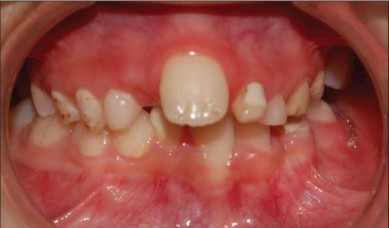(SICMMU, SMMCI)
Very rare: 1/50,000 births. A mutation of the SHH gene on 7q36, but also SIX3 on 2p21, ZIC2 on 13q32, TGIF on 18p11.3 or PTCH on 9q22.3 could be the cause. The presence of a single median central incisor is due to a lack of development of the median line of the craniofacial midface. Diagnosed around the age of 8 months, during the eruption of the first deciduous teeth, this dental anomaly is a warning sign, suggesting to search for other anomalies at the level of the median plane of the body as:
- nasal malformation: atresia or choanal stenosis, congenital stenosis of the pear-shaped hole
- cleft lip and/or palate, or an aspect of median lip pseudocleft before the dental eruption
- hypotelorism (45%), convergent squint
- severe to moderate (50%) intellectual deficit
- microcephaly (33%)
- abnormalities of the sella turcica and pituitary gland (10-50%); sometimes a panhypopituitarism (15%)
- an underactive thyroid
- atresia of esophagus or duodenum (10%)
- vertebral anomalies in the neck (15%)
- scoliosis
- a heart malformation (25%): tetralogy of Fallot
- a renal malformation
- a sexual ambiguity
There is a short stature linked to growth hormone deficiency in 50% of cases.
You can find this anomaly in case of (see these terms):
- holoprosencephaly
- CHARGE, VACTERL, velocardiofacial, ectodermal dysplasia, Duane syndrome, 47XXX
- deletion 18 p, deletion 7q36qter, deletion 22q11.2

Anesthetic implications:
differential diagnosis of nasal obstruction in the newborn; according to the anomalies associated with.
References :
- Hall RK.
Solitary Median Maxillary Central Incisor (SMMCI) syndrome.
Orphanet J Rare Diseases, 2006; doi: 10.1185/1750-1172-1-1-12 - Leraillez J.
L’obstruction nasale néonatale.
Arch Pédiatr 2001 ; 8 :214-20
Updated: March 2016